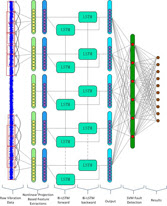
Machinery failure prediction and equipment health management is the key to reduce even prevent the occurrence of significant failures. In recent years, deep learning based intelligent fault diagnosis methods have become a hot topic of research in the field of machinery and equipment health management, especially the evaluation of the equipment health indicators and failure mode identification issues in complex environments. In this paper, a fused bidirectional long and short term memory (BiLSTM) and support vector machine (SVM) recurrent neural network deep learning algorithm is proposed to solve the problem of fast fault diagnosis of mechanical bearing vibration in complex environments. The algorithm uses a BiLSTM memory network as a feature extractor to capture fault features in the raw one dimensional (1-D) time series data, and then a SVM is used at the end of the network instead of the traditional softmax function as a classifier discriminator to further improve the accuracy of diagnosis. The experimental results indicate that the proposed algorithm model has higher diagnostic accuracy and faster diagnosis speed, and more suitable for fast diagnosis and real time detection of faults in complex environments.
Zhu Qingbo, JiaLin Han, Cheng Shi, Haoling Gao, "Prediction of Bearing Vibration Fault State based on Fused Bi-LSTM and SVM" in Journal of Imaging Science and Technology, 2023, pp 1 - 10, https://doi.org/10.2352/J.ImagingSci.Technol.2023.67.4.040404
 Find this author on Google Scholar
Find this author on Google Scholar Find this author on PubMed
Find this author on PubMed

